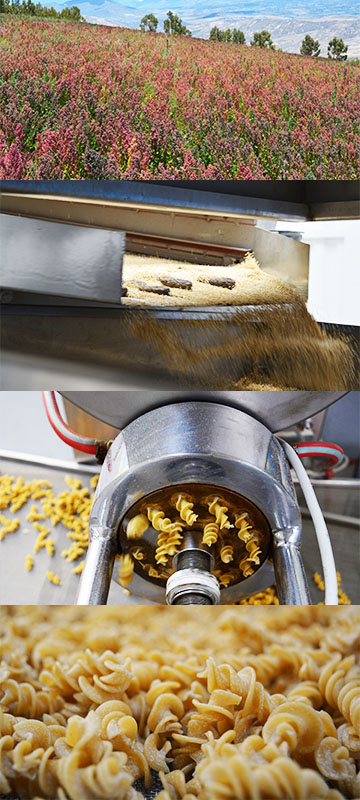Why Quinoa
PASTA PRODUCTION

A BIT MORE ABOUT QUINOA
Quinoa is not just a nutritious superfood. Quinoa is also a cultural legacy of the Andes as unlike foreign corns, which demands more resources and chemical supplies, the seed is capable of adapting to soil with limited organic matter and to differing elevations, from sea level to the plateaus.
It comes as no surprise then that the ancient grain is also knows as a food for better tomorrow – being classified as one of the most nutritious grains on the planet. Moreover, since 1993 it has been considered by NASA as the fittest food to guarantee the nutritional support of the astronauts in isolated conditions.
According to scientist Greg Schilick and David L. Bubenheim (from Nov 1993) for NASA, quinoa is a CELLS (Controlled Ecological Life Support System) crop. CELLS crops are those that can remove carbon dioxide from the atmosphere, or produce oxygen and water for the human crews on long-term space missions. The scientists explain that crops are evaluated based on their nutritional value, productivity of the harvest, appearance and life cycle. Quinoa has more than 16 % biological value protein – more than rice, wheat, barley, and soya – which makes it one of the few grains containing all the amino acids necessary to support life.
The year 2013 was also declared the International Year of the Quinoa by the Food and agricultural organization of the United Nations (FAO) with the aim of honouring the memory of the Andean communities and highlighting the important role quinoa will play in our nutritional future. Let’s explore why now.
Health Benefits
Unlike other cereals, such as rice and wheat, which carry amino acids in the skin, quinoas amino acids are in the core of the grain which protects them from the environment. It contains one of the most important amino acid – lysine – which helps the development of brain cells, learning processes, memorization and physical growth. Quinoa has 40% more lysine than milk (still considered exemplary food for humanity) which is why it is called a super cereal despite the fact that it is not considered an actual cereal but a seed.
Other important amino acids include:
- Phenylalanine – a powerful endogenous painkiller
- Iso-leucine – important for protecting muscle tissues
- Leucine – anti-aging
- Threonine – good for liver detoxification
- Tryptophan – regulating serotonin levels in the brain
- Valine – regulating nitrogen production.
This amino acid content satisfies the amino acid requirements recommended for both children and adults.
Quinoa also helps prevent decalcification of the bones and osteoporosis thanks to its calcium content which is easily absorbed by the body. The digestive system is also supported by its high fiber content – 6% which also lowers blood cholesterol.
Being rich in phytoestrogens, the super grain also helps reduce the symptoms of chronic illnesses such as arteriosclerosis, breast cancer, and other post-menopausal ailments that are caused by lack of estrogen. Thanks to its high levels of magnesium and phosphorus, quinoa also supports the health of the heart, the nervous system and the brain.
The presence of B vitamins further improves energy production, red blood cells and thus the immune system. As a gluten free product, quinoa is ideal for sufferers of celiac disease. However, research also shows that quinoa even helps sufferers of gluten allergies recover proper functioning of their intestines as the regular consumption of quinoa can restore the normal function of the intestinal capillaries much more quickly than a simple gluten free diet.
When it comes to its mineral content, quinoa also possesses more iron, calcium and phosphorus than eggs or meat. Also it has a high content of Omega-3, 6 and 9.
Beyond this extensive list of physical attributes that science has discovered in quinoa, there is yet another benefit that hasn’t been analysed in depth – quinoa is transforming the lives of thousands in the poorest areas of Peru. Research shows that quinoa cultivation could help farmers escape from poverty faster than any social program.
Traditional Use
Many traditional communities have developed various ways of using the whole quinoa plant so that nothing is wasted. Here are some examples:
Practical
- The tender the leaves – consumed as vegetables in soups.
- The ash resulting from the burnt stems kneaded with boiled potatoes -used to chew coca.
- The dry plants after harvest – used as fodder for the cattle.
Medicinal
- For sprains and contusions (ground grain);
- To make a person sweat and for chest pain (boiled grain)
- As emetic (grain flour dissolved in water);
- As antispasmodic (local application of boiled seeds);
- For laxative and as diuretic (drinking boiled stems);
- Gynaecologic (infusion of the leaves)
Modern Use
Besides its historic, economic and social impact, quinoa has the ability to adjust easily to every imaginable cuisine. As a grain it is prepared or be boiled or stewed to the delight of each seasoning. By introducing quinoa in place of potato, rice, corn or meat you can transform a recipe into an exquisite dish with a high nutritional value.
As we can see, quinoa – a grain that sustained countless pre-Columbian cultures is now making its presence in the diet of the whole world and we, at INKKA, are proud to be part of this expansion.
